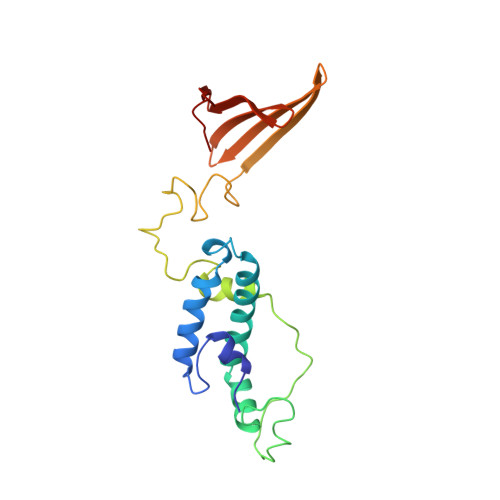Unraveling the structure and dynamics of the human DNAJB6b chaperone by NMR reveals insights into Hsp40-mediated proteostasis.
Karamanos, T.K., Tugarinov, V., Clore, G.M.(2019) Proc Natl Acad Sci U S A 116: 21529-21538
- PubMed: 31591220
- DOI: https://doi.org/10.1073/pnas.1914999116
- Primary Citation of Related Structures:
6U3R, 6U3S - PubMed Abstract:
J-domain chaperones are involved in the efficient handover of misfolded/partially folded proteins to Hsp70 but also function independently to protect against cell death. Due to their high flexibility, the mechanism by which they regulate the Hsp70 cycle and how specific substrate recognition is performed remains unknown. Here we focus on DNAJB6b, which has been implicated in various human diseases and represents a key player in protection against neurodegeneration and protein aggregation. Using a variant that exists mainly in a monomeric form, we report the solution structure of an Hsp40 containing not only the J and C-terminal substrate binding (CTD) domains but also the functionally important linkers. The structure reveals a highly dynamic protein in which part of the linker region masks the Hsp70 binding site. Transient interdomain interactions via regions crucial for Hsp70 binding create a closed, autoinhibited state and help retain the monomeric form of the protein. Detailed NMR analysis shows that the CTD (but not the J domain) self-associates to form an oligomer comprising ∼35 monomeric units, revealing an intricate balance between intramolecular and intermolecular interactions. The results shed light on the mechanism of autoregulation of the Hsp70 cycle via conserved parts of the linker region and reveal the mechanism of DNAJB6b oligomerization and potentially antiaggregation.
- Laboratory of Chemical Physics, National Institute of Diabetes and Digestive and Kidney Diseases, National Institutes of Health, Bethesda, MD 20892-0520.
Organizational Affiliation:
















